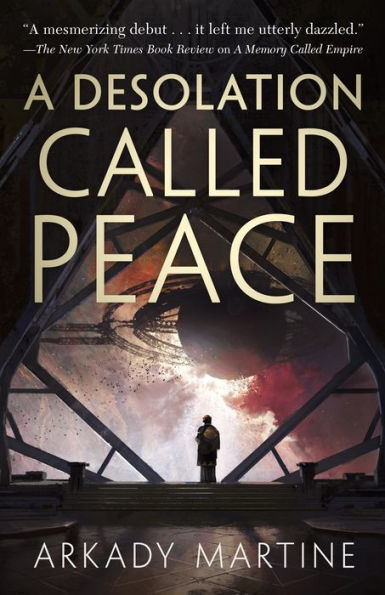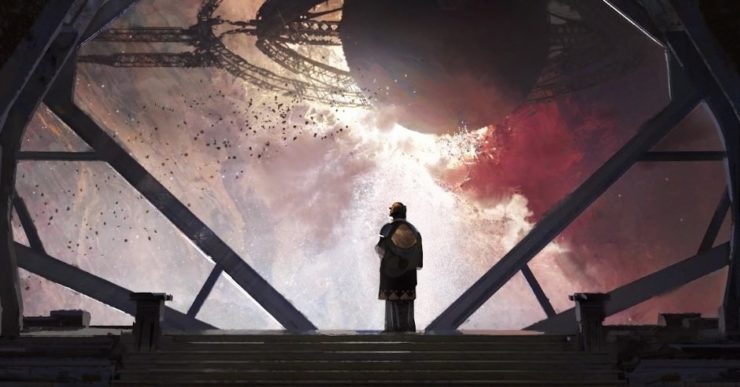Arkady Martine’s latest book, A Desolation Called Peace, picks up a few months after the events of her Hugo-winning novel A Memory Called Empire (which I wrote about here). The Teixcalaan series continues to be heavily influenced by works like C.J. Cherryh’s Foreigner series and Ann Leckie’s Ancillary Justice, drawing science fiction into a deeper conversation about what it means to be human. I noticed one obvious reference to Foreigner—a Captain Cameron, who’s a spaceship pilot in a comic book Mahit picks up—as well as a more subtle one, in which a Teixcalaanli character says they don’t believe in numerical luck anymore.
Ambassador Mahit Dzmare is back on Lsel Station, in a bit of disgrace and with the Station government breathing down her neck. Her friend Three Seagrass is still in Teixcalaan (the city) and decides to assign herself a request from the front of the war: the aliens they’re fighting communicate in some way, and the commander wants someone from the Information Ministry to come initiate first contact, or at least try. The sounds the aliens make are dissonant, and they make the human listener nauseated.
The book has only been out for a few weeks, but discussing it without spoilers (at least for this part of the story) is proving impossible, so be forewarned if you haven’t read it: there be spoilers ahead!
A Desolation Called Peace opens with the aliens’ POV:
To think—not language. To not think language. To think, we, and not have a tongue-sound or cry for its crystalline depths. To have discarded tongue-sounds where they are unsuitable.
They describe the humans they encounter as “clever meat” and as a “we that fragments,” and they want to learn more about this strange meat: What singing is their singing, that we cannot hear?
This sets up a truly alien species, which a regular reader of SF will probably assume has some sort of hive mind or distributed consciousness. These aliens don’t consider this clever meat that doesn’t sing we to be people, but they do want to understand this meat.
Buy the Book


A Desolation Called Peace
The Empire is at war with an unknown enemy that has cut off communication with one of their resource-mining planets. The enemy is able to move incredibly quickly and seems to appear out of nowhere and move together, as if with one thought. Nine Hibiscus, the fleet commander at the front, sends her scoutship Knifepoint out to see what the alien ships are doing, and when they return, they’ve intercepted a communication. The sounds don’t have parsable phonemes, and they’re nothing like anything humans can make.
Knifepoint’s captain tells Nine Hibiscus that it was “not language,” but it was definitely communication because it was responsive to their actions (approaching the ship) and changed in response to their reactions. This is a good distinction to make: language is communication, but not all communication is language. Prairie dogs, for example, make different calls for different types of threats, which is clearly communication, but there is no evidence that it’s language. (Some argue this is species-ist, defining language in such a way that it is inherently something only humans can do, while what other animals do is merely communication. I’m not a cognition specialist, so I’m staying out of this fight.)
Nine Hibiscus sends for someone from the Information Ministry to attempt to make first contact, and Three Seagrass assigns herself to the role and decides to get Mahit, because she’s brilliant, even though she’s a barbarian. Three Seagrass and Mahit travel to Nine Hibiscus’ ship, Weight for the Wheel, where they listen to the intercepted communication. Neither of them is prepared for what comes out of the infofiche stick: it sounded like bad static or cosmic interference; it was a “sharp, ugly noise that felt like a headache” and “ended in a scream that had a taste: foul, oilslick, nauseating.” They listen to it again and match the sounds to Knifepoint’s movements from the log and try to map them to meaning or communicative intent.
While our heroines are in transit, a pilot finds a dead alien in the wreckage of battle, and the ship’s physician performs an autopsy. They determine that it’s mammalian and vaguely humanoid, but the neck is too long and there are too many sharp teeth.
Mahit and Three Seagrass, in their effort to get the aliens to stop killing people by contacting them in order to negotiate, put together sounds that they hope mean “approach-danger-stop,” “contact initiated,” and “victory,” and play these sounds back to the aliens. Fortunately, it works, but because there is no language-as-such that either of them can figure out, they then switch to sending images, depicting humans and aliens landing on the planet, not fighting, and communicating. This also works, and Mahit and Three Seagrass meet with two aliens on the desert planet below them.
Again, they try using visual communication, with success, and Three Seagrass has a wild idea: the aliens use resonance when they make their calls, so she does the only thing humans do that makes resonance like that: she sings. The aliens respond to this, and our linguist-translator-diplomats (*cough*) are able to establish some twenty vocabulary items, mostly nouns. They also get some verbs, but they’re trickier: the sound they think means “fly” could also mean to pilot a ship or land a ship. As I’ve discussed in past columns, this is accurate to real encounters between groups of humans: we can hold up a ball and say ball, but rolling or throwing could be difficult. Eventually, Mahit decides the aliens have to have another language they can’t hear, because there aren’t any inflections, tenses, or causality in the pieces they’ve received. Someone figures out that there is instantaneous thought-sharing via a distributed consciousness, and that’s where they truly speak language.
Who figures it out, how the aliens create their group mind, and how this is tested is something I won’t spoil for you. There’s a lot of Teixcalaanli politics going on, and some of these are intertwined. Again, dedicated readers of SF are probably going to pick up on the clues, but a major part of the story is the process of Mahit, Three Seagrass, and Eight Antidote (the 11-year-old heir to the empire, who is deeply embroiled in the political machinations, unsurprisingly) figuring out what’s going on.
The aspect I think is most brilliant about this narrative is how it parallels the way the Teixcalaanli think about people outside the empire: they aren’t actually people; they’re barbarians. They’ve encountered a species who thinks about them the way they think about non-Teixcalaanli humans. I look forward to finding out how (and if) this affects the Empire in future books!
So what did you think of A Desolation Called Peace? Do you think Teixcalaan will learn anything from this encounter? Discuss in the comments!
CD Covington has masters degrees in German and Linguistics, likes science fiction and roller derby, and misses having a cat. She is a graduate of Viable Paradise 17 and has published short stories in anthologies, most recently the story “Debridement” in Survivor, edited by Mary Anne Mohanraj and J.J. Pionke. You can find her current project, a book on practical linguistics for writers, on Patreon.










